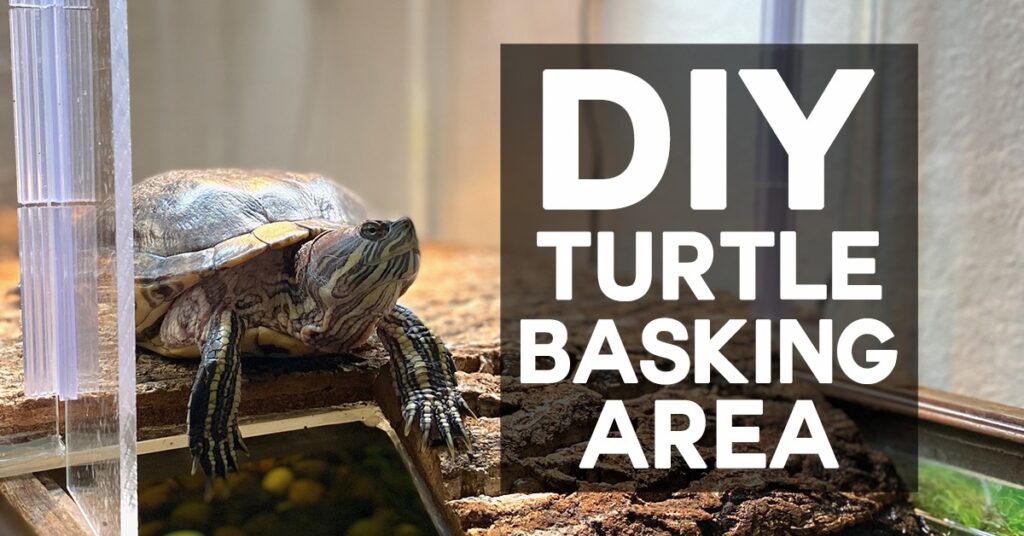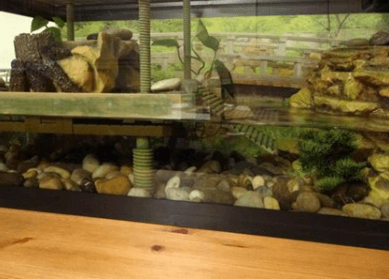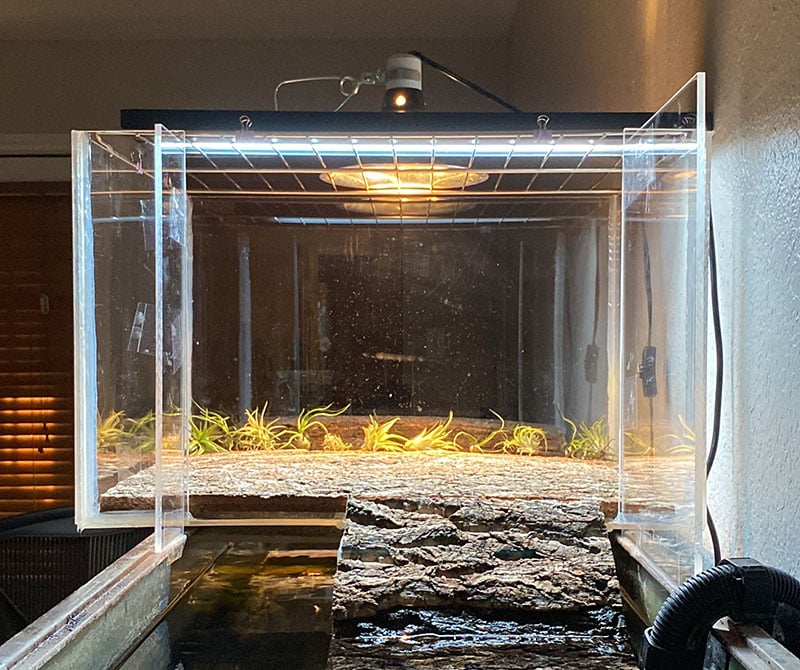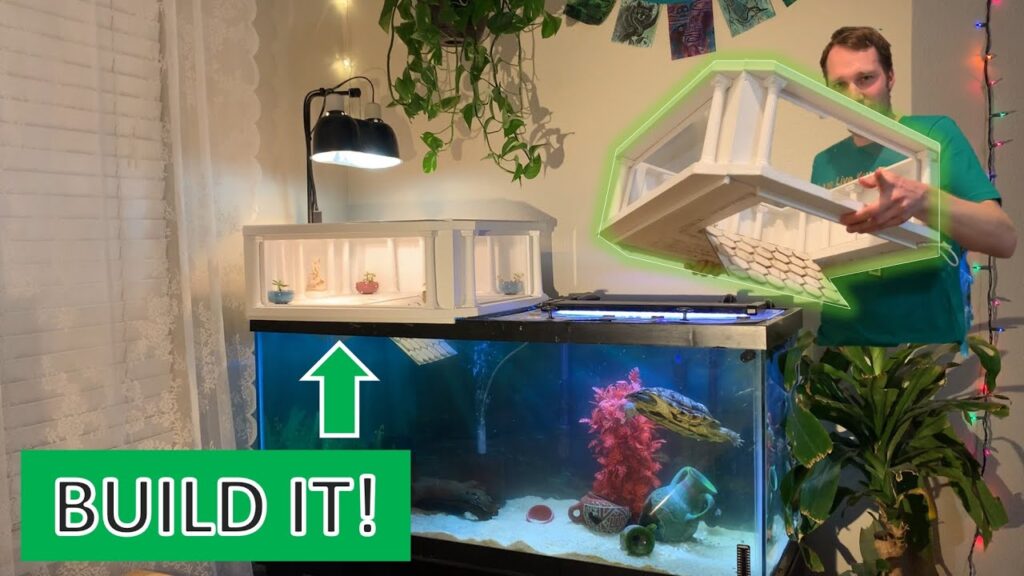So, you just got yourself a semi-aquatic turtle, huh? And now you’re wondering how to create the perfect basking area for them? Well, you’ve come to the right place! In this article, we’re going to dive into all the details on how you can provide a comfortable and optimal basking spot for your little shelled friend.
Before we get started, let me tell you that creating a basking area for your semi-aquatic turtle is crucial for their overall health and well-being. As you probably already know, these turtles need both land and water to thrive. And the basking area is where they can soak up some warmth and UV rays to regulate their body temperature and get some much-needed vitamin D.
Now, don’t worry if you’re not sure where to start or if you’re new to turtle care. We’re going to walk you through all the steps and provide you with some handy tips and tricks along the way. So, let’s get started and create the perfect basking area for your semi-aquatic turtle together! Stay tuned for more in-depth information in the rest of the article.

Selecting the Right Materials
When it comes to creating a basking area for your semi-aquatic turtle, selecting the right materials is crucial. This will ensure the safety and well-being of your turtle while also providing them with an enriched environment. Here are some important considerations when choosing materials for your basking area.
Choosing a Suitable Container
The first step in creating a basking area for your turtle is selecting a suitable container. This can be a tank, tub, or pond, depending on the size and species of your turtle. It is important to choose a container that is large enough for your turtle to comfortably swim and bask in. The container should also have a secure lid or cover to prevent escape.
Selecting the Right Substrate
The substrate in your turtle’s basking area plays an important role in maintaining a clean and healthy environment. It should be easy to clean and non-toxic to your turtle. Some suitable substrates for a basking area include river rocks, gravel, or sand. Avoid using small pebbles or gravel that can be ingested by your turtle.
Adding Decorative Elements for Enrichment
In addition to the basic materials, adding decorative elements to your turtle’s basking area can provide enrichment and stimulation. This can include floating plants, rocks, logs, or even a small island for your turtle to climb onto. These elements not only create a more natural and visually appealing environment, but also offer hiding spots and opportunities for exercise.
Setting Up the Basking Area
Once you have selected the right materials for your turtle’s basking area, it’s time to set it up in a way that meets their specific needs. Here are some important factors to consider when setting up the basking area.
Determining the Ideal Location
The location of your turtle’s basking area is crucial for their overall well-being. You should place it in an area that receives ample natural light but is also away from drafts or direct heat sources. This will help to maintain proper temperature and lighting conditions for your turtle.
Ensuring Proper Temperature and Lighting
Maintaining the right temperature and lighting conditions is essential for your turtle’s health. The basking area should have a heat lamp or basking light that provides a temperature gradient ranging from 90 to 95 degrees Fahrenheit. This allows your turtle to regulate their body temperature effectively. Additionally, you should provide UVB lighting to meet their vitamin D requirements.
Creating a Ramp or Platform for Access
To ensure that your turtle can easily access the basking area, it is important to provide a ramp or platform. This can be a gently sloping ramp or a floating dock that allows your turtle to climb onto the basking spot. The ramp or platform should be sturdy and secure to prevent accidents or injuries.

Preparing the Water Section
A semi-aquatic turtle requires both a water section and a basking area to thrive. Here are some important considerations when preparing the water section of your turtle’s enclosure.
Providing Sufficient Space and Depth
The water section should be large enough to allow your turtle to comfortably swim and dive. The depth of the water should be such that your turtle can fully submerge themselves without any difficulty. As a general guideline, the water section should be at least twice the length of your turtle.
Maintaining Clean and Filtered Water
It is crucial to maintain clean and filtered water in the turtle’s enclosure. Regularly changing and filtering the water will help to remove any waste or debris, ensuring a healthy and hygienic environment for your turtle. Invest in a reliable filtration system that is suitable for the size of your turtle’s enclosure.
Ensuring Proper Water Quality
In addition to filtration, regularly monitoring and maintaining proper water quality is essential. This includes checking the pH levels, ammonia levels, and temperature of the water. Using a water testing kit can help you ensure that the water parameters are within the suitable range for your turtle’s species.
Securing the Basking Area
Creating a secure basking area is important to prevent any accidents or escape attempts. Here are some steps you can take to ensure the safety of your turtle.
Preventing Escape Routes
Turtles are known to be skilled escape artists, so it’s important to secure the basking area. Ensure that the lid or cover of the enclosure is strong and well-fitted to prevent any escape attempts. You can also consider adding a barrier or mesh to the sides of the basking area to further prevent any potential escapes.
Ensuring Safety Measures for the Turtle
While basking, turtles may accidentally fall into the water section and get stuck. To avoid such instances, make sure there is a significant space between the basking area and the water surface. You can use a platform or create a barrier to ensure that your turtle can easily access the basking area without the risk of falling into the water.
Avoiding Potential Dangers
Remove any sharp or hazardous objects from the basking area that could potentially harm your turtle. This includes removing any sharp edges or objects that could cause injuries. Additionally, avoid placing any heating elements or lights directly above the basking area to prevent overheating or burns.

Monitoring and Maintaining the Basking Area
Once the basking area is set up, it is important to regularly monitor and maintain it to ensure the well-being of your turtle. Here are some key tasks to keep in mind.
Regularly Checking Temperature and Humidity Levels
To ensure a proper basking environment, monitor the temperature and humidity levels regularly. Use a thermometer and hygrometer to check the temperature and humidity in the basking area. Adjust the heat lamp or basking light as needed to maintain the ideal temperature gradient.
Monitoring Water Parameters
In addition to monitoring temperature and humidity, regularly test and monitor the water parameters in the turtle’s enclosure. This includes checking the pH levels, ammonia levels, and temperature of the water. Maintain proper water quality by regularly changing and filtering the water, as well as following any necessary water treatment protocols.
Cleaning and Maintaining the Basking Spot
Regularly cleaning and maintaining the basking spot is essential for your turtle’s health and well-being. Remove any waste, debris, or uneaten food from the basking area and surrounding substrate. This helps prevent bacterial or fungal growth and keeps the basking area clean for your turtle.
Encouraging Natural Behaviors
Creating a basking area is not just about providing a spot for your turtle to rest. It should also encourage their natural behaviors and provide them with opportunities for enrichment. Here are some ways to achieve this.
Introducing Hiding Spots
Turtles naturally seek out hiding spots for security and privacy. Consider adding caves, plants, or other hiding spots in or near the basking area. This allows your turtle to retreat and feel safe when they need a break from basking or swimming.
Providing Opportunities for Exercise
In addition to basking, turtles require regular exercise to stay healthy. Incorporate elements in the basking area that encourage physical activity, such as floating toys, tunnels, or climbing structures. This allows your turtle to engage in natural behaviors and stay active.
Offering a Varied Diet
A varied and balanced diet is essential for your turtle’s overall health. Ensure that their diet includes a mix of commercial turtle pellets, fresh vegetables, and live or frozen food. This provides them with the necessary nutrients and helps stimulate their natural feeding behaviors.

Avoiding Common Mistakes
When creating a basking area for your turtle, it is important to avoid common mistakes that can compromise their health and well-being. Here are some mistakes to watch out for.
Not Providing Enough Space
Turtles require ample space to swim, bask, and exercise. Avoid overcrowding the basking area with too many decorations or unnecessary objects. Providing enough space ensures that your turtle can move freely and engage in natural behaviors.
Neglecting Temperature and Lighting Needs
Maintaining proper temperature and lighting conditions is essential for your turtle’s health. Failing to provide the right heat and UVB lighting can lead to various health issues, including metabolic bone disease. Ensure that the basking area is adequately heated and that your turtle has access to proper UVB lighting.
Lack of Proper Filtration
Proper filtration is necessary to maintain clean and healthy water for your turtle. Insufficient or inadequate filtration can lead to poor water quality, which can negatively impact your turtle’s overall health. Invest in a reliable filtration system that is suitable for the size of your turtle’s enclosure.
Proper Handling and Interaction
While it’s important to provide a suitable basking area for your turtle, it is equally important to handle and interact with them properly. Here are some guidelines to follow when handling your semi-aquatic turtle.
Avoiding Rough Handling
Handle your turtle with care and avoid rough or excessive handling. Turtles can become stressed or injured if mishandled, so it’s important to be gentle and patient. Support their body properly and avoid grabbing or squeezing them.
Understanding the Turtle’s Body Language
Turtles communicate through body language, and it’s important to understand their cues and behavior. Learn to recognize signs of stress, fear, or aggression in your turtle. This allows you to respond appropriately and provide a calm and safe environment for them.
Promoting Respectful Interaction
Interact with your turtle in a respectful manner. Avoid actions that may startle or scare them, such as shouting or making sudden movements. Instead, approach them calmly, speak softly, and allow them to approach you at their own pace.

Training the Turtle
Training your turtle can be a rewarding experience for both you and your pet. Here are some tips for training your semi-aquatic turtle.
Implementing Positive Reinforcement Techniques
Turtles respond well to positive reinforcement techniques. Use treats or favorite foods as rewards for desired behaviors, such as coming to you when called or swimming through a hoop. Be patient and consistent in your training efforts.
Teaching Basic Commands
Start with basic commands such as “come” or “stay” to establish a foundation for further training. Use a consistent voice command along with a hand gesture or visual cue to reinforce the desired behavior. With time and practice, your turtle can learn to respond to these commands.
Promoting Mental Stimulation
In addition to physical exercise, providing mental stimulation is important for your turtle’s well-being. Use puzzle feeders, toys, or interactive games to engage your turtle’s mind and keep them mentally stimulated. This helps prevent boredom and promotes a healthy, active lifestyle.
Establishing a Regular Care Routine
To ensure the health and happiness of your semi-aquatic turtle, establish a regular care routine. Here are some essential tasks to include in your routine.
Cleaning and Maintaining the Tank
Regularly clean and maintain the turtle’s tank or enclosure. Remove any waste, uneaten food, or debris from the basking area and water section. Clean the filter and check the water quality regularly.
Monitoring the Turtle’s Health
Regularly monitor the overall health of your turtle. Check for any signs of illness or injury, such as lethargy, changes in appetite, or shell abnormalities. Address any health concerns promptly by consulting a veterinarian who specializes in reptiles.
Providing Regular Veterinary Care
Semi-aquatic turtles require regular veterinary care to ensure their long-term health. Schedule regular check-ups with a reptile veterinarian who can perform routine examinations and address any specific care needs for your turtle.
Troubleshooting Common Issues
Occasionally, you may encounter common issues with your turtle’s basking area. Here are some tips to troubleshoot and address these issues.
Algae Growth in the Tank
Algae growth is a common problem in turtle tanks. To control algae, maintain proper water quality and cleanliness. Limit the amount of light exposure in the tank and consider adding algae-eating fish or snails as natural cleaners.
Dealing with Water Odor
Foul odor from the water section can be a sign of poor water quality. Ensure that the water is properly filtered, changed regularly, and maintained at the appropriate temperature. Regularly remove any waste or uneaten food to prevent bacterial growth and odor.
Remedies for Shell Problems
Shell problems, such as shell rot or shell deformities, can occur in turtles. To prevent and treat shell problems, maintain proper water quality, provide a basking area with adequate UVB lighting, and offer a balanced diet. If you notice any abnormalities or damage to the shell, seek veterinary advice immediately.
Promoting Overall Well-being
Creating a basking area for your semi-aquatic turtle is not just about meeting their basic needs but also about promoting their overall well-being. Here are some ways to promote a healthy and happy turtle.
Offering Environmental Enrichment
Keep your turtle mentally stimulated by offering a variety of environmental enrichment. This can include changing the layout of the basking area, introducing new toys or obstacles, or adding live plants for your turtle to explore.
Providing Adequate Resting Areas
Turtles require ample resting areas to retreat and relax. Ensure that the basking area has comfortable and secure spots for your turtle to rest. This can include soft substrate, gentle slopes, or floating platforms.
Ensuring Proper Nutrition and Hydration
Proper nutrition and hydration are vital for your turtle’s overall well-being. Offer a balanced diet that includes a mix of commercial turtle pellets, fresh vegetables, and live or frozen food. Provide fresh, clean water for your turtle to drink and swim in.
Educating Yourself about Semi-Aquatic Turtles
To provide the best care for your semi-aquatic turtle, it is important to educate yourself about their species and natural habitat. Here are some steps to take.
Learning about Different Species
Semi-aquatic turtles belong to various species, each with their own unique care requirements. Take the time to learn about the specific species of your turtle, including their natural habitat, diet, and behavior. This allows you to create an environment that closely mimics their natural habitat.
Understanding their Natural Habitat
Understanding the natural habitat of semi-aquatic turtles is essential for their care. Research the temperature, humidity, and lighting conditions of their native habitat. Use this knowledge to replicate those conditions as closely as possible in your turtle’s enclosure.
Staying Informed about Legal Requirements
Ensure that you are aware of any legal requirements or restrictions regarding the ownership and care of semi-aquatic turtles in your area. Some species may require permits or specific enclosures. Stay informed to ensure that you are providing the appropriate care within the legal limits.
Conclusion
Creating a basking area for your semi-aquatic turtle is a rewarding and essential part of their care. By selecting the right materials, setting up the basking area correctly, and providing the necessary elements for enrichment, you can create an environment that promotes the health and well-being of your turtle. Remember to regularly monitor and maintain the basking area, promote natural behaviors, and establish a regular care routine. With proper care and attention, your semi-aquatic turtle can thrive and enjoy a happy and enriched life.